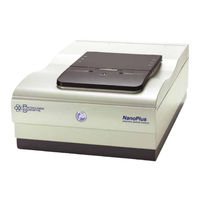Particulate Systems NanoPlus-1 Manuals
Manuals and User Guides for Particulate Systems NanoPlus-1. We have 1 Particulate Systems NanoPlus-1 manual available for free PDF download: Operator's Manual
Particulate Systems NanoPlus-1 Operator's Manual (252 pages)
Zeta Potential/Nano Particle Analyzer
Brand: Particulate Systems
|
Category: Laboratory Equipment
|
Size: 15 MB
Table of Contents
-
Conventions10
-
Nanoplus at11
-
Top Panel13
-
Side Panel14
-
Front Panel14
-
Rear Panel14
-
Labels15
-
Precautions16
-
After Use16
-
For Storage16
-
Commands18
-
Main Menu19
-
Pop-Up Menu20
-
SOP Designer22
-
Analysis55
-
Analysis66
-
Maintenance70
-
Cell Listing73
-
Security75
-
Buttons76
-
Copying Sops82
-
Adding a Diluent108
-
Adding Users111
-
Deleting Users112
-
Troubleshooting115
-
Maintenance120
-
Cell Maintenance121
-
Flow Cell122
-
Autotitrator149
-
Ph Electrode149
-
Maintenance168
-
Ph Electrode170
-
Size Flow Cell172
-
Consumables175
-
Tubing176
-
Detail177
-
Water179
-
Refractive Index179
-
Viscosity180
-
Other Liquids187
-
Table of Values189
-
References191
-
ACF Listing201
-
Normal Log ACF203
-
ACF (Base207
-
Test Measurement208
-
3D Graph209
-
Peak Value Table211
-
With Second Axis212
-
Graph Options214
-
Correlator220
-
Zeta Potential224
-
21 CFR Part233
-
Main Menu Bar236
-
Adding Users237
-
Using Playback245
Advertisement
